(完整版)高考英语阅读理解解题技巧及经典题型
- 格式:doc
- 大小:63.01 KB
- 文档页数:9
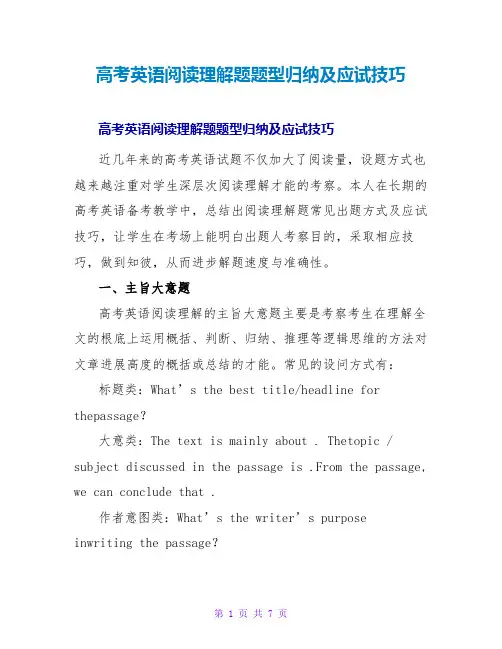
高考英语阅读理解题题型归纳及应试技巧高考英语阅读理解题题型归纳及应试技巧近几年来的高考英语试题不仅加大了阅读量,设题方式也越来越注重对学生深层次阅读理解才能的考察。
本人在长期的高考英语备考教学中,总结出阅读理解题常见出题方式及应试技巧,让学生在考场上能明白出题人考察目的,采取相应技巧,做到知彼,从而进步解题速度与准确性。
一、主旨大意题高考英语阅读理解的主旨大意题主要是考察考生在理解全文的根底上运用概括、判断、归纳、推理等逻辑思维的方法对文章进展高度的概括或总结的才能。
常见的设问方式有:标题类:W hat’s the best title/headline for thepassage?大意类:The text is mainly about . Thetopic / subject discussed in the passage is .From the passage, we can conclude that .作者意图类:What’s the writer’s purposeinwriting the passage?针对主旨大意类型的题,考生可以掌握以下解题策略:把握文章逻辑构造,快速找出主题;寻找主题句,确定文章中心思想;将首段中心句和各段第一句话连接成一个整体,得出文章主题;逆向思维法解标题类问题。
此类题关键在于通读全文,理解作者写作意图,不受干扰项细节影响,要把握好文章的大意,抓住文章的主题句,还应注意文章的体裁及写作目的。
二、数据推断题解答此类题,关键是要擅长捕捉有关数字的信息,然后在透彻理解原文的字面意义和题意的根底上,运用自己的数学知识,分列数字,对其进展分析^p 、推算,从而得出正确的结论。
如阅读理解题:……But now there is a Winter-swimmingEnthusiasts’Club and it has more than 2.000 mem.bers. The oldest is 84 years old and the youngest isonly 7. The members are from all walks oflife ……The question is : Among the winter-swimmersthe oldest is _____ years older than the youngestone.A. 91B. 84 C . 77 D. 7答案是C。
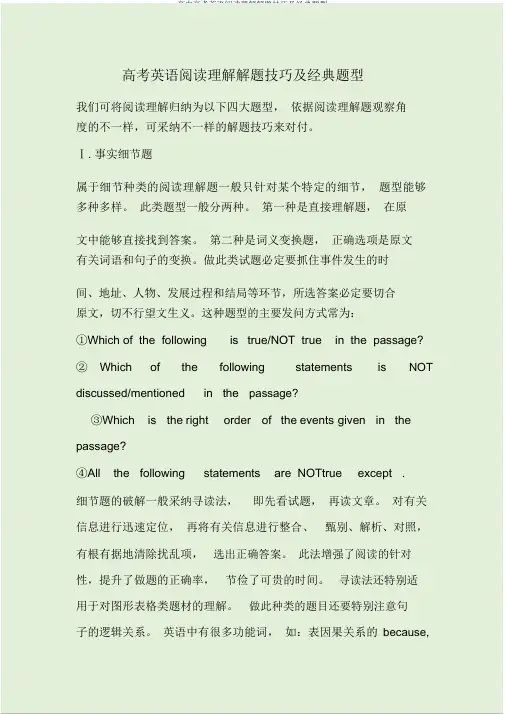
高考英语阅读理解解题技巧及经典题型我们可将阅读理解归纳为以下四大题型,依据阅读理解题观察角度的不一样,可采纳不一样的解题技巧来对付。
Ⅰ.事实细节题属于细节种类的阅读理解题一般只针对某个特定的细节,题型能够多种多样。
此类题型一般分两种。
第一种是直接理解题,在原文中能够直接找到答案。
第二种是词义变换题,正确选项是原文有关词语和句子的变换。
做此类试题必定要抓住事件发生的时间、地址、人物、发展过程和结局等环节,所选答案必定要切合原文,切不行望文生义。
这种题型的主要发问方式常为:①Which of the following is true/NOT true in the passage?②Which of the following statements is NOT discussed/mentioned in the passage?③Which is the right order of the events given in the passage?④All the following statements are NOTtrue except.细节题的破解一般采纳寻读法,即先看试题,再读文章。
对有关信息进行迅速定位,再将有关信息进行整合、甄别、解析、对照,有根有据地清除扰乱项,选出正确答案。
此法增强了阅读的针对性,提升了做题的正确率,节俭了可贵的时间。
寻读法还特别适用于对图形表格类题材的理解。
做此种类的题目还要特别注意句子的逻辑关系。
英语中有很多功能词,如:表因果关系的because,since, as 等;表转折关系的but, however ,on the contrary, on the other hand 等等。
Ⅱ. 猜想词义题在高考阅读题中,考生碰到的最大阻碍常常有两个:一是被已认识的单词的某一熟知含义所误导;二是被完好不认识的单词的意思所阻挡,进而出现理解误差或理解困难,影响阅读的速度。
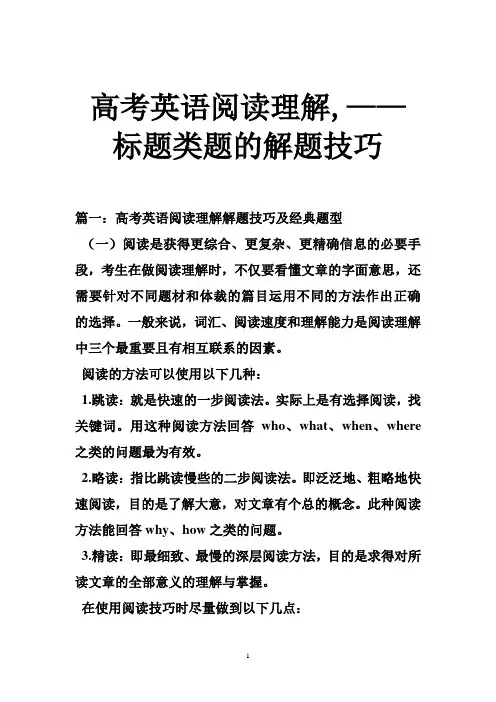
高考英语阅读理解,——标题类题的解题技巧篇一:高考英语阅读理解解题技巧及经典题型(一)阅读是获得更综合、更复杂、更精确信息的必要手段,考生在做阅读理解时,不仅要看懂文章的字面意思,还需要针对不同题材和体裁的篇目运用不同的方法作出正确的选择。
一般来说,词汇、阅读速度和理解能力是阅读理解中三个最重要且有相互联系的因素。
阅读的方法可以使用以下几种:1.跳读:就是快速的一步阅读法。
实际上是有选择阅读,找关键词。
用这种阅读方法回答who、what、when、where 之类的问题最为有效。
2.略读:指比跳读慢些的二步阅读法。
即泛泛地、粗略地快速阅读,目的是了解大意,对文章有个总的概念。
此种阅读方法能回答why、how之类的问题。
3.精读:即最细致、最慢的深层阅读方法,目的是求得对所读文章的全部意义的理解与掌握。
在使用阅读技巧时尽量做到以下几点:1.带着问题阅读短文。
2.找出主题句、确定中心思想。
3.推断单词、句子和文章的含义。
4.尽快选择答案。
(二)不同体裁文章的特点及解题技巧1.记叙文记叙文又可分传记类和故事类。
传记类文章在阅读中时间是全文的关键,根据时间我们可以找到相关的事件,抓住文章的主要内容。
故事类文章情节性较强,阅读时要注意故事中的时间、地点、人物和发生的事件,这些都是文章中的主要内容和信息,对于准确理解文章十分重要。
2.说明文说明文是对事物的形状、性质、特征、成果或功用等进行介绍,解释或阐述的文章。
把握所说明事物的特征和本质是理解说明文的关键。
说明事物特征的方法很多,主要有定义法、解释法、比较法、比喻法、数字法、图表法、引用法和举例法等。
? 数字说明文在阅读数字说明文时要特别注意文中数字的含义,从这些数字中可以找到文章的主要内容。
? 解释说明文解释说明文着重说明事物的本质、特征和功用等。
许多科普文章都属于这一类。
在阅读这类文章时要学会解决what, how, why 等一类的问题。
它们是文章的关键。
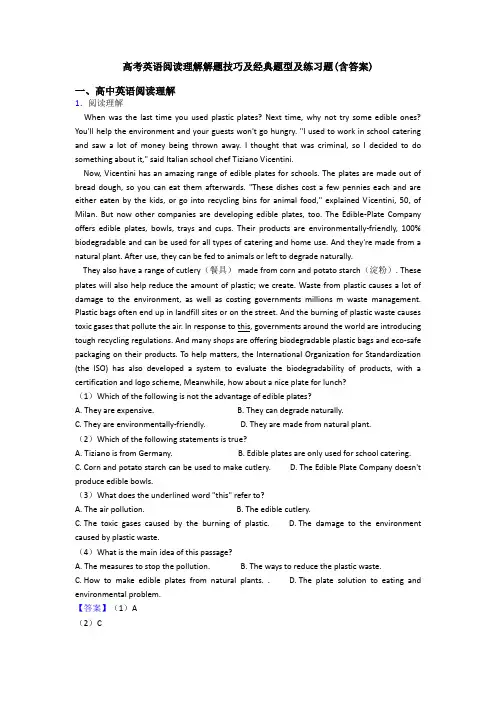
高考英语阅读理解解题技巧及经典题型及练习题(含答案)一、高中英语阅读理解1.阅读理解When was the last time you used plastic plates? Next time, why not try some edible ones? You'll help the environment and your guests won't go hungry. "I used to work in school catering and saw a lot of money being thrown away. I thought that was criminal, so I decided to do something about it," said Italian school chef Tiziano Vicentini.Now, Vicentini has an amazing range of edible plates for schools. The plates are made out of bread dough, so you can eat them afterwards. "These dishes cost a few pennies each and are either eaten by the kids, or go into recycling bins for animal food," explained Vicentini, 50, of Milan. But now other companies are developing edible plates, too. The Edible-Plate Company offers edible plates, bowls, trays and cups. Their products are environmentally-friendly, 100% biodegradable and can be used for all types of catering and home use. And they're made from a natural plant. After use, they can be fed to animals or left to degrade naturally.They also have a range of cutlery(餐具) made from corn and potato starch(淀粉). These plates will also help reduce the amount of plastic; we create. Waste from plastic causes a lot of damage to the environment, as well as costing governments millions m waste management. Plastic bags often end up in landfill sites or on the street. And the burning of plastic waste causes toxic gases that pollute the air. In response to this, governments around the world are introducing tough recycling regulations. And many shops are offering biodegradable plastic bags and eco-safe packaging on their products. To help matters, the International Organization for Standardization (the ISO) has also developed a system to evaluate the biodegradability of products, with a certification and logo scheme, Meanwhile, how about a nice plate for lunch?(1)Which of the following is not the advantage of edible plates?A. They are expensive.B. They can degrade naturally.C. They are environmentally-friendly.D. They are made from natural plant.(2)Which of the following statements is true?A. Tiziano is from Germany.B. Edible plates are only used for school catering.C. Corn and potato starch can be used to make cutlery.D. The Edible Plate Company doesn't produce edible bowls.(3)What does the underlined word "this" refer to?A. The air pollution.B. The edible cutlery.C. The toxic gases caused by the burning of plastic.D. The damage to the environment caused by plastic waste.(4)What is the main idea of this passage?A. The measures to stop the pollution.B. The ways to reduce the plastic waste.C. How to make edible plates from natural plants. .D. The plate solution to eating and environmental problem.【答案】(1)A(2)C(3)D(4)D【解析】【分析】本文是一篇说明文,介绍了饮食和环境的问题,并且提出了相应的解决方法。
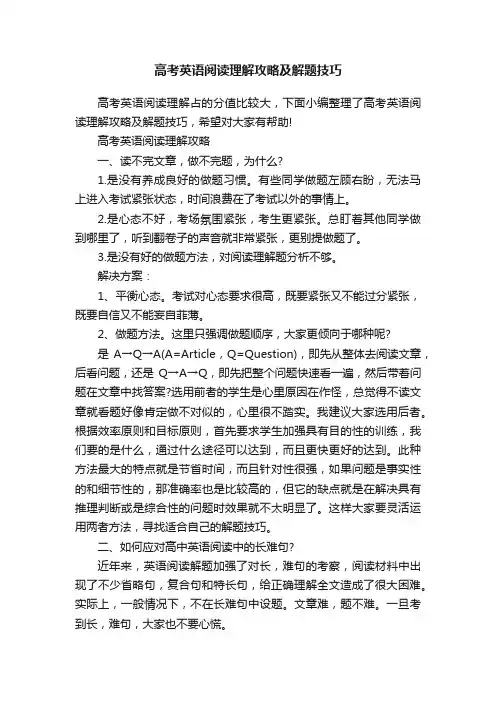
高考英语阅读理解攻略及解题技巧高考英语阅读理解占的分值比较大,下面小编整理了高考英语阅读理解攻略及解题技巧,希望对大家有帮助!高考英语阅读理解攻略一、读不完文章,做不完题,为什么?1.是没有养成良好的做题习惯。
有些同学做题左顾右盼,无法马上进入考试紧张状态,时间浪费在了考试以外的事情上。
2.是心态不好,考场氛围紧张,考生更紧张。
总盯着其他同学做到哪里了,听到翻卷子的声音就非常紧张,更别提做题了。
3.是没有好的做题方法,对阅读理解题分析不够。
解决方案:1、平衡心态。
考试对心态要求很高,既要紧张又不能过分紧张,既要自信又不能妄自菲薄。
2、做题方法。
这里只强调做题顺序,大家更倾向于哪种呢?是A→Q→A(A=Article,Q=Question),即先从整体去阅读文章,后看问题,还是Q→A→Q,即先把整个问题快速看一遍,然后带着问题在文章中找答案?选用前者的学生是心里原因在作怪,总觉得不读文章就看题好像肯定做不对似的,心里很不踏实。
我建议大家选用后者。
根据效率原则和目标原则,首先要求学生加强具有目的性的训练,我们要的是什么,通过什么途径可以达到,而且更快更好的达到。
此种方法最大的特点就是节省时间,而且针对性很强,如果问题是事实性的和细节性的,那准确率也是比较高的,但它的缺点就是在解决具有推理判断或是综合性的问题时效果就不太明显了。
这样大家要灵活运用两者方法,寻找适合自己的解题技巧。
二、如何应对高中英语阅读中的长难句?近年来,英语阅读解题加强了对长,难句的考察,阅读材料中出现了不少省略句,复合句和特长句,给正确理解全文造成了很大困难。
实际上,一般情况下,不在长难句中设题。
文章难,题不难。
一旦考到长,难句,大家也不要心慌。
应对长难句的解题技巧:1利用还原法恢复句型的原貌。
例如:Betty shrugs. Talk? We're friends.(2001全国,C)该句为省略句,根据上文Harold对妻子长时间跟女友谈话而感到纳闷的情况,该剧课补充还原为:Betty shrugs. Why are we talking so long? We're friends.2 成分分析法。
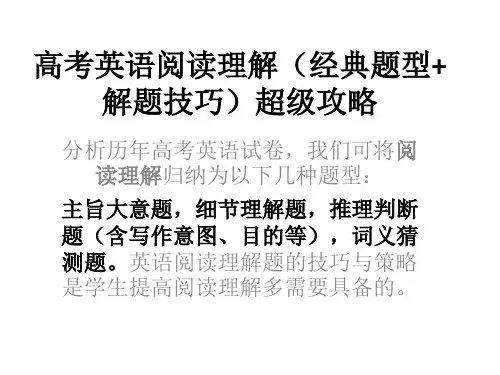
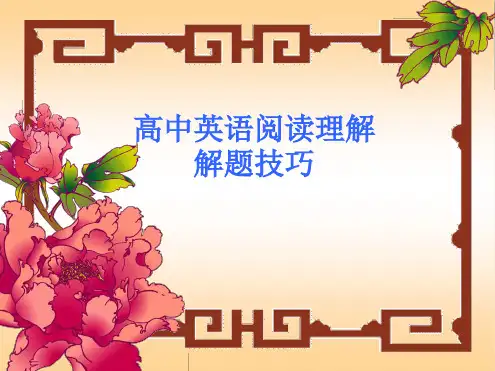
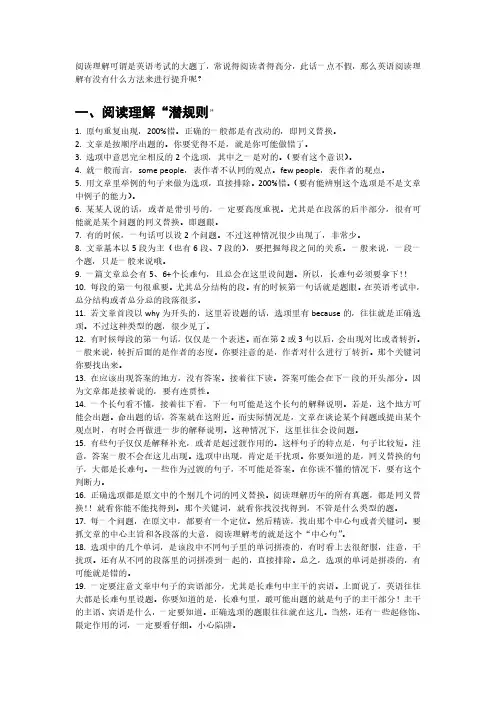
阅读理解可谓是英语考试的大题了,常说得阅读者得高分,此话一点不假,那么英语阅读理解有没有什么方法来进行提升呢?一、阅读理解“潜规则”1.原句重复出现,200%错。
正确的一般都是有改动的,即同义替换。
2.文章是按顺序出题的。
你要觉得不是,就是你可能做错了。
3.选项中意思完全相反的2个选项,其中之一是对的。
(要有这个意识)。
4.就一般而言,some people,表作者不认同的观点。
few people,表作者的观点。
5.用文章里举例的句子来做为选项,直接排除。
200%错。
(要有能辨别这个选项是不是文章中例子的能力)。
6.某某人说的话,或者是带引号的,一定要高度重视。
尤其是在段落的后半部分,很有可能就是某个问题的同义替换。
即题眼。
7.有的时候,一句话可以设2个问题。
不过这种情况很少出现了,非常少。
8.文章基本以5段为主(也有6段、7段的),要把握每段之间的关系。
一般来说,一段一个题,只是一般来说哦。
9.一篇文章总会有5、6+个长难句,且总会在这里设问题。
所以,长难句必须要拿下!!10.每段的第一句很重要。
尤其总分结构的段。
有的时候第一句话就是题眼。
在英语考试中,总分结构或者总分总的段落很多。
11.若文章首段以why为开头的,这里若设题的话,选项里有because的,往往就是正确选项。
不过这种类型的题,很少见了。
12.有时候每段的第一句话,仅仅是一个表述。
而在第2或3句以后,会出现对比或者转折。
一般来说,转折后面的是作者的态度。
你要注意的是,作者对什么进行了转折。
那个关键词你要找出来。
13.在应该出现答案的地方,没有答案。
接着往下读。
答案可能会在下一段的开头部分。
因为文章都是接着说的,要有连贯性。
14.一个长句看不懂,接着往下看,下一句可能是这个长句的解释说明。
若是,这个地方可能会出题。
命出题的话,答案就在这附近。
而实际情况是,文章在谈论某个问题或提出某个观点时,有时会再做进一步的解释说明。
这种情况下,这里往往会设问题。
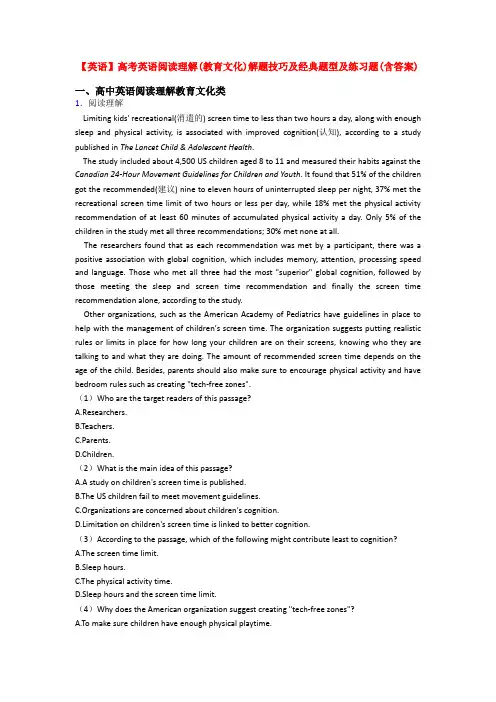
【英语】高考英语阅读理解(教育文化)解题技巧及经典题型及练习题(含答案)一、高中英语阅读理解教育文化类1.阅读理解Limiting kids' recreational(消遣的) screen time to less than two hours a day, along with enough sleep and physical activity, is associated with improved cognition(认知), according to a study published in The Lancet Child&Adolescent Health.The study included about 4,500 US children aged 8 to 11 and measured their habits against the Canadian24-Hour Movement Guidelines for Children and Youth. It found that 51% of the children got the recommended(建议) nine to eleven hours of uninterrupted sleep per night, 37% met the recreational screen time limit of two hours or less per day, while 18% met the physical activity recommendation of at least 60 minutes of accumulated physical activity a day. Only 5% of the children in the study met all three recommendations; 30% met none at all.The researchers found that as each recommendation was met by a participant, there was a positive association with global cognition, which includes memory, attention, processing speed and language. Those who met all three had the most "superior" global cognition, followed by those meeting the sleep and screen time recommendation and finally the screen time recommendation alone, according to the study.Other organizations, such as the American Academy of Pediatrics have guidelines in place to help with the management of children's screen time. The organization suggests putting realistic rules or limits in place for how long your children are on their screens, knowing who they are talking to and what they are doing. The amount of recommended screen time depends on the age of the child. Besides, parents should also make sure to encourage physical activity and have bedroom rules such as creating "tech-free zones".(1)Who are the target readers of this passage?A.Researchers.B.Teachers.C.Parents.D.Children.(2)What is the main idea of this passage?A.A study on children's screen time is published.B.The US children fail to meet movement guidelines.anizations are concerned about children's cognition.D.Limitation on children's screen time is linked to better cognition.(3)According to the passage, which of the following might contribute least to cognition?A.The screen time limit.B.Sleep hours.C.The physical activity time.D.Sleep hours and the screen time limit.(4)Why does the American organization suggest creating "tech-free zones"?A.To make sure children have enough physical playtime.B.To make sure children have enough sleep time.C.To make sure children have recreational time.D.To protect children against radiation.【答案】(1)C(2)D(3)C(4)B【解析】【分析】本文是一篇说明文,建议父母们要把孩子的屏幕消遣时间限制在2小时之内、保证孩子有足够的睡眠和锻炼,因为这样做可以让孩子有更好的认知能力。
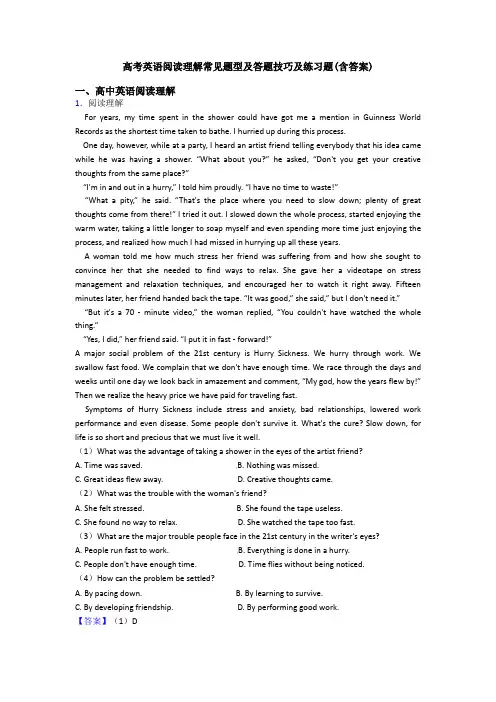
高考英语阅读理解常见题型及答题技巧及练习题(含答案)一、高中英语阅读理解1.阅读理解For years, my time spent in the shower could have got me a mention in Guinness World Records as the shortest time taken to bathe. I hurried up during this process.One day, however, while at a party, I heard an artist friend telling everybody that his idea came while he was having a shower. “What about you?” he asked, “Don't you get your creative thoughts from the same place?”“I'm in and out in a hurry,” I told him proudly. “I have no time to waste!”“What a pity,” he said. “That's the place where you need to slow down; plenty of great thoughts come from there!” I tried it out. I slowed down the whole process, started enjoying the warm water, taking a little longer to soap myself and even spending more time just enjoying the process, and realized how much I had missed in hurrying up all these years.A woman told me how much stress her friend was suffering from and how she sought to convince her that she needed to find ways to relax. She gave her a videotape on stress management and relaxation techniques, and encouraged her to watch it right away. Fifteen minutes later, her friend handed back the tape. “It was good,” she said,” but I don't need it.”“But it's a 70 - minute video,” the woman replied, “You couldn't have watched the whole thing.”“Yes, I did,” her friend said. “I put it in fast - forward!”A major social problem of the 21st century is Hurry Sickness. We hurry through work. We swallow fast food. We complain that we don't have enough time. We race through the days and weeks until one day we look back in amazement and comment, “My god, how the years flew by!” Then we realize the heavy price we have paid for traveling fast.Symptoms of Hurry Sickness include stress and anxiety, bad relationships, lowered work performance and even disease. Some people don't survive it. What's the cure? Slow down, for life is so short and precious that we must live it well.(1)What was the advantage of taking a shower in the eyes of the artist friend?A. Time was saved.B. Nothing was missed.C. Great ideas flew away.D. Creative thoughts came.(2)What was the trouble with the woman's friend?A. She felt stressed.B. She found the tape useless.C. She found no way to relax.D. She watched the tape too fast.(3)What are the major trouble people face in the 21st century in the writer's eyes?A. People run fast to work.B. Everything is done in a hurry.C. People don't have enough time.D. Time flies without being noticed.(4)How can the problem be settled?A. By pacing down.B. By learning to survive.C. By developing friendship.D. By performing good work.【答案】(1)D(2)A(3)B(4)A【解析】【分析】本文为应用文。
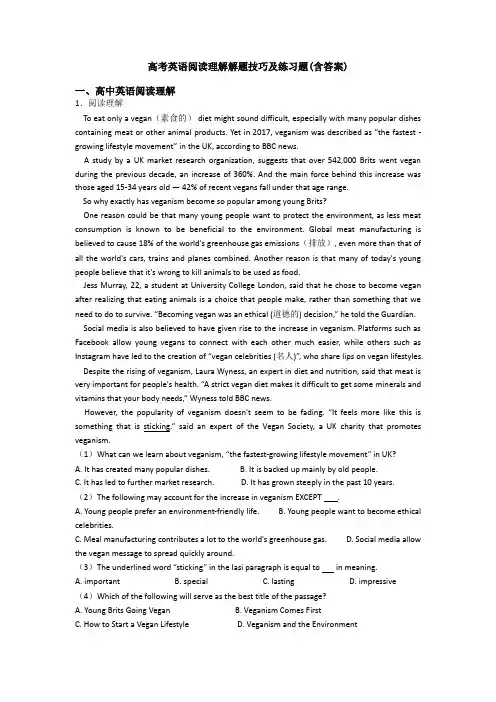
高考英语阅读理解解题技巧及练习题(含答案)一、高中英语阅读理解1.阅读理解To eat only a vegan(素食的) diet might sound difficult, especially with many popular dishes containing meat or other animal products. Yet in 2017, veganism was described as “the fastest - growing lifestyle movement” in the UK, according to BBC news.A study by a UK market research organization, suggests that over 542,000 Brits went vegan during the previous decade, an increase of 360%. And the main force behind this increase was those aged 15-34 years old — 42% of recent vegans fall under that age range.So why exactly has veganism become so popular among young Brits?One reason could be that many young people want to protect the environment, as less meat consumption is known to be beneficial to the environment. Global meat manufacturing is believed to cause 18% of the world's greenhouse gas emissions(排放), even more than that of all the world's cars, trains and planes combined. Another reason is that many of today's young people believe that it's wrong to kill animals to be used as food.Jess Murray, 22, a student at University College London, said that he chose to become vegan after realizing that eating animals is a choice that people make, rather than something that we need to do to survive. “Becoming vegan was an ethica l (道德的) decision,” he told the Guardian. Social media is also believed to have given rise to the increase in veganism. Platforms such as Facebook allow young vegans to connect with each other much easier, while others such as Instagram have led to the creation of “vegan celebrities (名人)”, who share lips on vegan lifestyles. Despite the rising of veganism, Laura Wyness, an expert in diet and nutrition, said that meat is very important for people's health. “A strict vegan diet makes it difficult to ge t some minerals and vitamins that your body needs,” Wyness told BBC news.However, the popularity of veganism doesn't seem to be fading. “It feels more like this is something that is sticking.” said an expert of the Vegan Society, a UK charity that pro motes veganism.(1)What can we learn about veganism, “the fastest-growing lifestyle movement” in UK?A. It has created many popular dishes.B. It is backed up mainly by old people.C. It has led to further market research.D. It has grown steeply in the past 10 years.(2)The following may account for the increase in veganism EXCEPT .A. Young people prefer an environment-friendly life.B. Young people want to become ethical celebrities.C. Meal manufacturing contributes a lot to the world's greenhouse gas.D. Social media allow the vegan message to spread quickly around.(3)The underlined word “sticking” in the Iasi paragraph is equal to in meaning.A. importantB. specialC. lastingD. impressive(4)Which of the following will serve as the best title of the passage?A. Young Brits Going VeganB. Veganism Comes FirstC. How to Start a Vegan LifestyleD. Veganism and the Environment【答案】(1)D(2)B(3)C(4)A【解析】【分析】本文是一篇说明文,研究表明,过去的十年里素食主义在英国增长迅猛。
高考英语阅读理解各种题型及解题技巧汇总例证题1.例证题的标记。
当题干中出现example, case, illustrate, illustration, exemplify时。
2.返回原文,找出该例证所在的位置,既给该例子定位。
3.搜索该例证周围的区域,90%向上,10%向下,找出该例证支持的观点。
例子周围具有概括抽象性的表达通常就是它的论点。
注意:举例的目的是为了支持论点或是为了说明主题句。
举例后马上问这个例子说明了什么问题?不能用例子中的话来回答这个问题。
4.找出该论点,并与四个选项比较,得出选项中与该论点最一致的答案。
5.例证题错误答案设计的干扰特征经常是:就事论事。
即用例子中的某一内容拉出来让你去选。
(一般不会是正确选项)要求:在阅读中,遇到长的例子,立即给这个例子定位,即找出起始点,从哪开始到哪结束。
指代题1.返回原文,找出出题的指代词。
2.向上搜索,找最近的名词、名词性短语或句子(先从最近点开始找,找不到再找次近的,一般答案不会离得太远)。
3.将找到的词、词组或句子的意思代入替换该指代词,看其意思是否通顺。
4.将找到的词、词组或句子与四个选项进行比较,找出最佳答案。
词汇题“搜索代入”法:返回原文,找出该词汇出现的地方。
确定该词汇的词性。
从上下文(词汇的前后几句)中找到与所给词汇具有相同词性的词(如一下子找不到就再往上往下找),代入所给词汇在文章中的位置(将之替换)看语义是否合适找出选项中与代替词意思相同或相近的选相,即答案注意:a.如果该词汇是简单词汇,则其字面意思一般不是正确答案。
b.高考阅读不是考察字认识不认识,而是考察是否能根据上下文作出正确的判断。
c.词汇题的正确答案经常蕴藏在原文该词汇出现的附近。
注意不能靠单词词义直接往下推。
d.寻找时要注意同位语、特殊标点(比如分号,分号前后两句话的逻辑关系不是形式上的并列就是语义上的并列,也就是两句话的意思相同,所以可用其中一句话的意思来推测另一句话的意思从而推出所给词汇含义)、定语从句、前后缀,特别要注意寻找时的同性原则。
高考英语阅读理解解题技巧及经典题型高考英语阅读理解题型主要有主旨大意题,细节理解题,推理判断题,词义猜想题等,下面是英语阅读理解经典题型及解题技巧,希望能对大家有所帮助!高考英语阅读理解题型主要有主旨大意题,细节理解题,推理判断题,词义猜想题等,下面是英语阅读理解经典题型及解题技巧,希望能对大家有所帮助!高考英语阅读常见题型主旨大意题这类题在设题时常会用到title,subject,main idea,topic,theme等词。
1.归纳标题题特点:短小精悍,一般多为一个短语;涵盖性强,一般能覆盖全文意思;准确性强,表达范围要恰当,不能随意改变语意程度或色彩。
常见命题形式有:What’s the best title for the text?The best title for this passage is___.Which of the following can be the best title for the passage?真题范例Why is pink or purple a color for girls and blue or brown for boys? The answer depends largely on cultural values as well as personalexperiences.To the Egyptians,green was a color that represented the hope and joy of spring,while for Muslims,it means heaven.Red is a symbol of good luck in many cultures.In China,children are given money in a red envelope to bring good fortune in the New Year.For many nations,blue is a symbol of protection and religious beliefs.Greek people often wear a blue necklace hoping to protect themselves against evils(灾祸).People#39;s choice of colors is also influenced by their bodies#39; reactions(反响)toward them.Green is said to be the most restful color. It has the ability to reduce pain and relax people both mentally and physically.People who work in green environment have been found to have fewer stomach aches.Red can cause a person#39;s blood pressure to rise and increase people#39;s appetites(食欲).Many decorators will include different shades of red in the restaurant.Similarly,many commercial websites will have a red Buy Now button because red is a color that easily catches a person#39;s eye.Blue is another calming color.Unlike red,blue can cause people to lose appetite.So if you want to eat less,some suggest that eating from blue plates can help.The next time you are deciding on what to wear or what color to decorate your room,think about the color carefully.63.Which of the following would be the most proper title for the text?A.Colors and Human BeingsB.The Cultural Meaning of ColorC.Colors and Personal ExperiencesD.The Meaning and Function of Color答案:D概括大意题包括寻找段落大意〔topic〕和文章中心思想〔main idea〕,常见命题形式有:What is the general/main idea of the passage?Which of the following expresses the main idea?What is the subject discussed in the text?BThe writer of the story wants to tell us that_____.The passage/ text is mainly about_____.What’s the article mainly about?★真题范例Joshua Bingham studied4years at the University of Paris and decided to leave his graduation.He transferred to the University of Berlinand graduated with honors.Harvard Law School and,later,Boston College provided him with an excellent legal background.He is presently a corporation lawyer in Miami,Florida.Q:What is the main idea of the passage?__A.How Joshua Bingham became a lawyer.B.Bingham is a diligent student.C.Joshua Bingham received an excellent education.D.A good lawyer needs good education.答案:C解题思路:此文没有主题句。
高考英语阅读文体类型及阅读理解答题技巧湖北省荆门市屈家岭管理区五三高中杨卫红谌金洲一、英语阅读文体类型简析阅读是一种理解、吸收、鉴赏、评价文章的思维过错。
完成这个思维过程,则需要经过认知、分析、综合、理解、记忆、感受、判断等程序。
文体类别不同,决定着叙述风格的差异。
掌握文体风格,识别文章叙述结构,对正确领悟文章主旨有极大的帮助。
高考英语阅读常见的文体类型有:记叙文、议论文、说明文和应用文。
记叙文体又可细分为小说、时文报道、人物传记及轶闻趣事。
阅读时如能弄清文体类型,能了解把握文体结构和写作特征,对我们更快、更准地把脉作者的写作思路、理解作者的写作意图有极大的帮助。
[1]、记叙文。
英语记叙文以描写叙述为主,主要描写人物、事件、地点、或过程。
特点是,其主题往往潜伏在字里行间,没有直接地表白出来;文章主旨要透过体察所揭示的人物、事件来进行提炼。
描写手法大多按时间跨度、空间顺序、上下顺序来展开。
阅读记叙文体应采取掠读和扫读的方法,快速抓住文中描写的主要内容,从整体上去把握文章的连贯性,进而大体上揣测出作者的写作意图及情感主线。
高考阅读就记叙文设题大多以细节理解为主。
[2]、议论文。
英语议论文通常为三段式,即“论点、论据、结论”三部份组成。
首先借助某一现象引出论点,然后通过一定论据从各个层面上加以推理论证,最后得出结论。
议论文体主要考查学生对论点及论据的把握。
因此,遇到议论文体时,应采取抓主题句的方法来把握文章主旨,弄清作者的观点。
一般来说,作者的论点通常在文章首段被引出,接着是对这一论点的逻辑推理和论证,最后为结论。
还应注意的是:在对论点论证的过程中,每一段的首句都是该段的主题句。
把握全文论点、弄清论证各段的主题句、理解文章层次、找出中心论点的位置是理解议论文的关键。
就议论文而言,其论证的常见结构方式有:1,总分式总---分;分----总;总----分---总;2,并列式几个论据之间属于平等关系;3,递进式几个论据之间属于递进关系4,对照式把两种事物加以对比,以彰显其中一种;[3]、说明文。
高考英语阅读理解满分解题技巧有哪些高考英语阅读理解满分解题技巧一1.迅速将整篇文章分解,理出文章结构;2.迅速抓住文章叙述的主题;3.迅速找出各部分的中心意思,并找出表达中心意思的句子。
做到这3步,基本上这篇文章不用逐字读完就可以答对接下来的题目。
先说一下,英语文章,尤其是用于考试的阅读文章,其结构都有非常明显的典型性,一般结构为主题段,论述段落,总结及结论段,乃至超长的毕业论文也不过是在这个大框架内。
以一篇文章5段为例:一般第一段为主题段,也就是说,整篇文章要表达的主题一定会出现在这里,你要做的就是迅速把中心句找出来,一般来说,中心句会出现在倒数第2句或第1句,简单一点的文章会在第1句就出现,如果考题出得比较难,也可能需要自己总结,但就算需要自己总结中心句,也一定能在该段落中找出代表中心意思的词;接下来第二、三、四段,各段将对第一段提出的主题意思进行论述或分步骤分析,也就是说,每个段落都会有进阶的主题,即个各分论点,所以你要做的同样是迅速把它们找出来,位置和方法相同;最后一段为全文的总结,并会对结论进行进一步的分析,或做推测,或作评论,这也是一个出题点,你要做的就是抓住总结的主旨和对其进一步分析的结论。
当然并不会所有文章都是5段,例如有的主题段落会有2段甚至更多,论点段落可能只有2段或多达4段以上(但一般不超过3段),难一点的文章里每个分论点也可能不止一段,我这里只是以5段为例,解释的是文章的结构,或者说一般构成,通过这个规律可以迅速将文章进行分解,进而掌握各部分的要点。
下面分析一下出题要点,或者说出题规律(如果题不会出得很偏的话),以一篇阅读文5题为例,一般为1个主题、1个分论点、2个细节题、1个结论或对结论的分析、推测。
可见掌握文章主题、分论点及结论分析就可以答对3/5,这是不需要逐字逐句读完全文的,而2个细节题怎么办呢,就需要通过题目提供的信息迅速分析出其所在的分论点,然后回到该分论点段落找到与这题相符的句子,一般如果题出得简单的话会是原句照搬,难一点的话会换个表达方式,再难一点则会绕个圈设个陷阱,这就需要非常小心,一定要舍得多花2秒钟把这句话和前后两句反复阅读,挖出陷阱。
高考英语阅读理解4类题型解题攻略+7大解题技巧题型分类一、主旨大意题这类题在设题时常会用到title, subject, main idea, topic, theme等词。
1.归纳标题题特点:短小精悍,一般多为一个短语;涵盖性强,一般能覆盖全文意思;精确性强,表达范围要恰当,不能随意改变语意程度或色彩。
常见命题形式有:What’s the best title for the text?The best title for this passage is ___.Which of the following can be the best title for the passage?2. 概括大意题包括寻找段落大意(topic)和文章中心思想(main idea),常见命题形式有:What is the general/main idea of the passage?Which of the following expresses the main idea?What is the subject discussed in the text?What’s the article mainly about ?解题技巧阅读理解文章多是议论文和说明文,这两种文体的结构可归纳为:提出问题——论述问题——得出结论或者阐明观点。
对于这类文章,抓主题句是快速掌握文章大意的主要方法。
主题句一般出现在文章的开头或结尾。
主题句具有简洁性、概括性的特点。
主题句在文章中的位置主要有以下几种情况。
位于段首:一般而言,以演绎法撰写的文章,主题句往往在文章的开头,即先点出主题,然后围绕这一主题作具体的陈述。
判断第一句是否为主题句,可具体分析段落的首句与第二,三句的关系;如果从第二句就开始对第一句进行说明,论述或描述,那第一句就是主题句。
有些段落,在主题句后面有明显引出细节的信号词,如for example, an example of; first, second, next, last, finally; to begin with, also, besides; one, the other; some, others等。
高考英语阅读理解满分技巧(9大题型+解题技巧)例证题1.例证题的标记。
当题干中出现example, case, illustrate, illustration, exemplify时。
2.返回原文,找出该例证所在的位置,既给该例子定位。
3.搜索该例证周围的区域,90%向上,10%向下,找出该例证支持的观点。
例子周围具有概括抽象性的表达通常就是它的论点。
注意:举例的目的是为了支持论点或是为了说明主题句。
举例后马上问这个例子说明了什么问题?不能用例子中的话来回答这个问题。
4.找出该论点,并与四个选项比较,得出选项中与该论点最一致的答案。
5.例证题错误答案设计的干扰特征经常是:就事论事。
即用例子中的某一内容拉出来让你去选。
(╳)要求:在阅读中,遇到长的例子,立即给这个例子定位,即找出起始点,从哪开始到哪结束。
指代题1.返回原文,找出出题的指代词。
2.向上搜索,找最近的名词、名词性短语或句子(先从最近点开始找,找不到再找次近的,一般答案不会离得太远)。
3.将找到的词、词组或句子的意思代入替换该指代词,看其意思是否通顺。
4.将找到的词、词组或句子与四个选项进行比较,找出最佳答案。
词汇题“搜索代入”法:①返回原文,找出该词汇出现的地方。
②确定该词汇的词性③从上下文(词汇的前后几句)中找到与所给词汇具有相同词性的词(如一下子找不到就再往上往下找),代入所给词汇在文章中的位置(将之替换)看语义是否合适④找出选项中与代替词意思相同或相近的选相,即答案注意:a.如果该词汇是简单词汇,则其字面意思必然不是正确答案。
b.高考阅读不是考察字认识不认识,而是考察是否能根据上下文作出正确的判断。
c.词汇题的正确答案经常蕴藏在原文该词汇出现的附近。
注意不能靠单词词义直接往下推。
d.寻找时要注意同位语、特殊标点(比如分号,分号前后两句话的逻辑关系不是形式上的并列就是语义上的并列,也就是两句话的意思相同,所以可用其中一句话的意思来推测另一句话的意思从而推出所给词汇含义)、定语从句、前后缀,特别要注意寻找时的同性原则。
(一)阅读是获得更综合、更复杂、更精确信息的必要手段,考生在做阅读理解时,不仅要看懂文章的字面意思,还需要针对不同题材和体裁的篇目运用不同的方法作出正确的选择。
一般来说,词汇、阅读速度和理解能力是阅读理解中三个最重要且有相互联系的因素。
阅读的方法可以使用以下几种:1.跳读:就是快速的一步阅读法。
实际上是有选择阅读,找关键词。
用这种阅读方法回答who、what、when、where之类的问题最为有效。
2.略读:指比跳读慢些的二步阅读法。
即泛泛地、粗略地快速阅读,目的是了解大意,对文章有个总的概念。
此种阅读方法能回答why、how之类的问题。
3.精读:即最细致、最慢的深层阅读方法,目的是求得对所读文章的全部意义的理解与掌握。
在使用阅读技巧时尽量做到以下几点:1.带着问题阅读短文。
2.找出主题句、确定中心思想。
3.推断单词、句子和文章的含义。
4.尽快选择答案。
(二)不同体裁文章的特点及解题技巧1.记叙文记叙文又可分传记类和故事类。
传记类文章在阅读中时间是全文的关键,根据时间我们可以找到相关的事件,抓住文章的主要内容。
故事类文章情节性较强,阅读时要注意故事中的时间、地点、人物和发生的事件,这些都是文章中的主要内容和信息,对于准确理解文章十分重要。
2.说明文说明文是对事物的形状、性质、特征、成果或功用等进行介绍,解释或阐述的文章。
把握所说明事物的特征和本质是理解说明文的关键。
说明事物特征的方法很多,主要有定义法、解释法、比较法、比喻法、数字法、图表法、引用法和举例法等。
●数字说明文在阅读数字说明文时要特别注意文中数字的含义,从这些数字中可以找到文章的主要内容。
●解释说明文解释说明文着重说明事物的本质、特征和功用等。
许多科普文章都属于这一类。
在阅读这类文章时要学会解决what, how, why 等一类的问题。
它们是文章的关键。
如能带着这些问题阅读,将会更迅速抓住文章的主题。
比较说明文比较说明文是通过对比方法说明问题。
在阅读这类文章时要善于把握全篇陈述的基本倾向。
作者在谈论一个有争议的问题时总要顾及到争议的各个方面。
但是,在一般情况下,作者的陈述总要倾向于某一种观点。
3.应用文应用文涉及的范围比较广,包括广告、通知、书信等。
应用文一般语言简洁,省略及不规范的句子较多。
阅读时一般要求考生全面掌握文章中提供的信息,并运用这些信息去解决问题。
因此对题干的理解尤为重要。
阅读理解的考题分为客观理解题(是指在短文中客观存在的事实,客观信息的答案一般都可以在原文中找到。
即理解文中的具体事实或抽象概念)和主观理解题(这类问题都不可能直接从原文中找到答案,须通过阅读文章对文章主旨和深层含义有更深理解,并据此进行判断和推理)。
其中细节理解题和猜测词义题属于客观题;主旨大意题和推理判断题属于主观题。
针对不同类型的题目,要在平时的练习过程中,结合具体的题目,给学生进行解题方法的指导和讲解。
对于客观题,要提醒他们阅读时关注文章的细节,如时间,地点或一些具体数字,在选择答案时,务必从原文中找到确切的依据。
我们可将阅读理解归纳为以下四大题型,根据阅读理解题考查角度的不同,可采用不同的解题技巧来应付。
Ⅰ.事实细节题属于细节类型的阅读理解题一般只针对某个特定的细节,题型可以多种多样。
此类题型一般分两种。
第一种是直接理解题,在原文中可以直接找到答案。
第二种是词义转换题,正确选项是原文有关词语和句子的转换。
做此类试题一定要抓住事件发生的时间、地点、人物、发展过程和结局等环节,所选答案一定要符合原文,切不可望文生义。
这类题型的主要提问方式常为:①Which of the following is true/NOT true in the passage?②Which of the following statements is NOT discussed/mentioned in the passage?③Which is the right order of the events given in the passage?④All the following statements are NOT true except .细节题的破解一般采用寻读法,即先看试题,再读文章。
对有关信息进行快速定位,再将相关信息进行整合、甄别、分析、对比,有根有据地排除干扰项,选出正确答案。
此法加强了阅读的针对性,提高了做题的准确率,节省了宝贵的时间。
寻读法还特别适用于对图形表格类题材的理解。
做此类型的题目还要特别注意句子的逻辑关系。
英语中有许多功能词,如:表因果关系的because, since, as 等;表转折关系的but, however ,on the contrary, on the other hand等等。
Ⅱ.猜测词义题在高考阅读题中,考生遇到的最大障碍往往有两个:一是被已认识的单词的某一熟知含义所误导;二是被完全不认识的单词的意思所阻碍,从而出现理解偏差或理解困难,影响阅读的速度。
其实解决这两个困难的一个重要法宝是考生在心目中树立起上下文观念,要学会"顺藤摸瓜",通过构词,语法,定义,同位,对比,因果,常识,上下文等线索确定词义。
在阅读解题时要注意从以下七个方面着手:1)根据定义或解释、说明猜测生词的词义在be,be called,call等判断词出现的判断句中,或定语从句及标点符号,可以根据已知部分,猜测生词的含义。
例如:The herdsman, who looks after sheep, earns about 650 yuan a year.通过理解定语从句的意思,能猜出herdsman是“牧人”。
2)根据对比关系猜测生词的词义在but,however,yet,otherwise,though这些表示意义转折的连词出现的句子中,其前后的词有明显对比关系,根据已知的内容,通过这种对比关系,就很容易猜出生词的词义了。
例如:Though Tom’s face has been washed quite clean, his neck still remains grubby. 和clean意思相对的便是“肮脏的”了,因此可猜出句中grubby 的意思是“肮脏的”。
3)通过因果关系猜测词义because, since与as是连接原因状语从句的从属连词,so是连接表示结果的状语从句的连词,so...that与such...that中的that是连接结果状语从句的。
当这些信息词出现在有生词的句子中,通过因果关系,依据已知部分就能猜出生词的词义。
例如:She wanted the hairdresser to trim her hair a bit because it was too long. 根据because从句所讲的意思,我们就可推测trim就是“修剪”之意。
4)根据生活常识猜测词义运用逻辑推理能力,自身的生活经验及生活常识。
再联系上下文能读懂的部分,可以正确猜出词义。
例如:Most of the roses are beginning to wither because of the cold. 根据句子意思及生活经验,wither表示“枯萎”。
5)根据同等关系猜测词义同等关系,指的是一个词,一组词或短语在句中作同一成分,而且它们的词义都属于同一范畴。
明显的标志是,这样的词组或短语中间常常用并列连词and或or来连接。
例如:At forty-two he was in his prime and always full of energy. 从“年龄42岁”以及与prime具有同等关系的full of energy可以猜出prime的意思是“盛年时期”。
6)根据列举的事例猜测词义You can t ake any of the periodicals: “The World of English”. “Foreign Language Teaching in Schools”, or “English Learning”. 从后面列举的例子中,可以猜出periodical是“期刊,杂志”的意思。
7)根据构词法知识猜测词义根据学过的构词法知识,知道词根和前缀或后缀的意义,就可猜出由它们组成的新词词义。
例如在2006年福建的高考题文章中有这样一句:The schools are reluctant to take off — even teachers with tickets for the England-Argentina game had trouble getting the day off.A.kindB.unwillingC. freeD.careless 【解题思路】通过破折号可知正确答案为B.Ⅲ.推理判断题做这类题要求考生在阅读理解整体语篇的同时,又要求学生对作者的态度、意图及文章细节的发展作正确的推理判断,力求从作者的角度去考虑,不要固守自己的看法或观点。
不要主观臆断,凭空想象,任意发挥,而走入误区。
学生要学会运用主题句去推测、揣摩文字背后作者的意图,运用归纳、对比、演绎技能,运用背景知识去挖掘文章深层含义,从而正确理解作者的言外之意,同时认真体会文章的语气与感情基调(如:否定、厌恶、反问、讽刺等)。
这类试题常以如下句式发问:①What can you conclude/ imply from this passage?②What’s the author’s attitude(态度)towards...?③We can infer /learn from the passage that...如:Once there was something wrong with a machine in a factory. The workers could do nothing but turn to a German engineer for help, who drew a line on it and said, “Take off the part where the line is and change it for a new one. ”The machine, with a new line on, began running well again. The engineer then asked for $ 30,000 for whathe had done. The following were what he wrote on a bill, “The new part only costs one dollar, and knowing where the problem with the machine is cost s $ 29,999.”Q: What can you conclude from this passage?A. the engineer asked for too much moneyB. the workers should pay the moneyC. the knowledge is worth moneyD. the new part could cost more这篇短文是作者讲的一个故事,那么通过这个故事我们可以判断出什么呢?虽然作者没有言明,但是我们可以断定,发现问题的所在需要智慧和知识,知识是创造价值的源泉,因此此题的正确答案应为C。